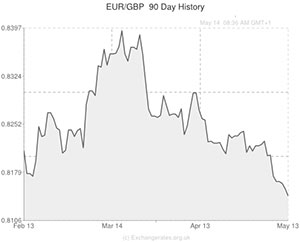
While the Pound fluctuated against the Euro following the release of UK jobs data, the Euro to GBP pairing remained close to a 16-month low as investors digested the Eurozone’s industrial production report.
Before the UK figures were published the Pound was enjoying a bullish relationship with several of its major rivals.
The UK employment report was expected to surprise to the upside, a fact which was helping to keep Sterling supported.
However, while Britain’s unemployment rate fell to a five-year low of 6.8 per cent – with the nation adding more positions than forecast in the three-months to March – jobless claims fell by less than hoped and Sterling rapidly pared gains.
Jobless claims were down by 25,100 in April rather than dropping the 30,000 expected.
Similarly, average weekly earnings climbed by less-than-projected in the three months to March, year-on-year, rising by 1.7 per cent instead of 2.1 per cent.
While the Pound initially erased its earlier gains against the Euro after the report was published, EUR/GBP strength was slightly undermined by the Eurozone’s industrial production report.
Seasonally adjusted industrial production in the 18-nation currency bloc fell by 0.3 per cent in March, month-on-month, as forecast.
On the year production was down by 0.1 per cent rather than up the 0.9 per cent anticipated.
The unforeseen annual decline was due to a sharp fall in energy production and was the first year-on-year drop since mid 2013.
According to Eurostat, who compiled the data, ‘The decrease of 0.3 per cent in industrial production in the Euro area in March 2014, compared with February 2014, is due to production of intermediate goods falling by 0.8 per cent, non-durable consumer goods by 0.5 per cent, energy by 0.4 per cent and capital goods by 0.3 per cent, while durable consumer goods remain stable.’
Bets that the European Central Bank will introduce additional stimulus next month continue to weigh heavily on the Euro and the common currency dropped to a two-month low against the Yen as European trading progressed.
Additional Euro to Pound movement occurred following the release of the Bank of England’s inflation report. While the central bank cut its unemployment forecast it hinted that it is in no hurry to start increasing borrowing costs.
The bank stated; ‘Although the margin of spare capacity has probably narrowed a little since then, the Monetary Policy Committee continues to judge that there remains scope to make greater inroads into slack before raising Bank Rate […] As set out in its February guidance, when the Committee does start to raise Bank Rate, it expects to do so only gradually and to a level materially below its pre-crisis average.’
There is little additional UK news to be aware of for the rest of the week so movement in the EUR/GBP pairing is more likely to be driven by economic news from the Eurozone, including tomorrow’s German/French growth data and the publication of the European Central Bank’s monthly report.
Euro to Pound Update – 15/05/2014
On Thursday the Euro to Pound exchange rate shed yesterday’s gains as a less-than-impressive growth report for the Eurozone upped the odds of the European Central Bank introducing additional stimulus in June.
The Bank of England’s dovish inflation report and slightly disappointing UK employment data saw the Pound slide against the Euro on Wednesday.
While the British asset remained in a weaker position against several of its most traded currency-counterparts during European trading, Sterling was able to recoup losses against the Euro.
The Euro slid against almost all of its peers, hitting an 11-week low against the US Dollar, after an ECB official intimated that stimulus is on the horizon.
ECB Vice President Vitor Constancio asserted that the central bank has ‘reaffirmed our forward guidance and stressed that we are determined to act swiftly if required and do not rule out further monetary policy easing.’
The appeal of the Euro also declined as a result of growth reports for the 18-nation currency bloc and its largest economies.
Although the German economy was shown to have expanded by more than anticipated in the first quarter, the performance of the French and Italian economies was less impressive.
Meanwhile, the Eurozone as a whole posted growth of 0.2 per cent in the first three months of the year, quarter-on-quarter, half the 0.4 per cent growth anticipated.
On the year the economy was 0.9 per cent stronger in the first quarter. Economists had forecast expansion of 1.1 per cent.
Economic weakness in nations like Portugal offset strength in more robust countries like Germany and added to the already mounting pressure on the ECB.
A separate report confirmed that the Eurozone’s consumer price index advanced by 0.2 per cent April month-on-month and was up 0.7 per cent on the year, as previously estimated.
The Euro shed 0.33 per cent against the Pound after the domestic reports were released.
With UK news lacking on both Thursday and Friday any further movement in the EUR/GBP pairing before the weekend is likely to be the result of tomorrow’s Eurozone trade figures.
Euro Exchange Rates
[table width=”100%” colwidth=”50|50|50|50|50″ colalign=”left|left|left|left|left”]
Currency, ,Currency,Rate ,
Euro, ,Pound Sterling,0.8162,
,Pound Sterling,0.8162,
Euro, ,US Dollar,1.3669,
,US Dollar,1.3669,
Euro, ,Canadian Dollar,1.4852,
,Canadian Dollar,1.4852,
Euro, ,Australian Dollar,1.4582,
,Australian Dollar,1.4582,
Euro, ,New Zealand Dollar,1.5779,
,New Zealand Dollar,1.5779,
US Dollar, ,Euro ,0.7316,
,Euro ,0.7316,
Pound Sterling, ,Euro,1.2252,
,Euro,1.2252,
Canadian Dollar, ,Euro,0.6734,
,Euro,0.6734,
Australian Dollar, ,Euro,0.6864,
,Euro,0.6864,
New Zealand Dollar, ,Euro,0.6342,
,Euro,0.6342,
[/table]

Comments are closed.